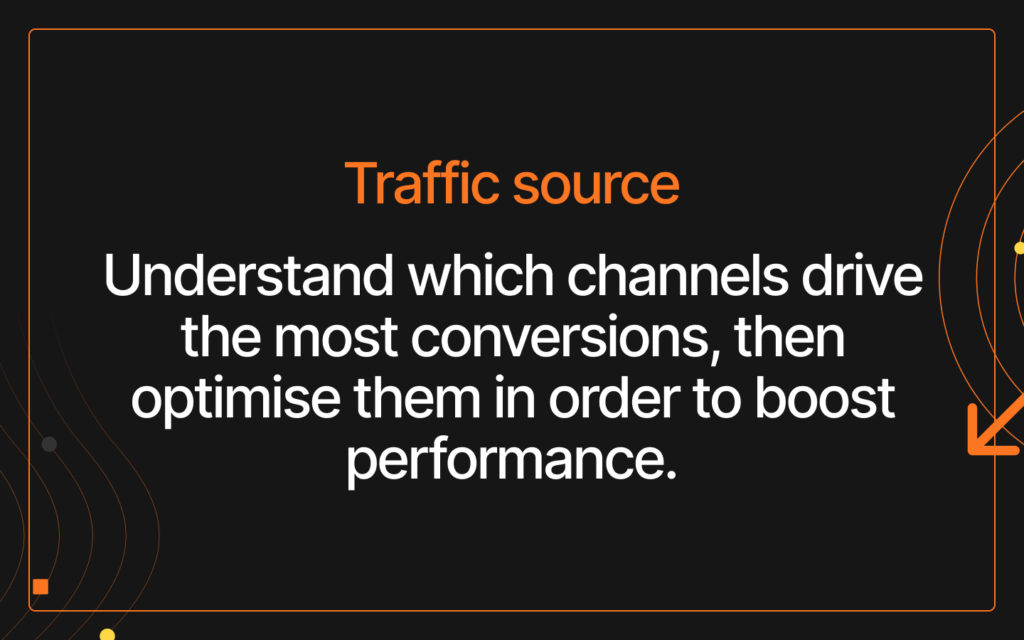| Key Metrics | Descriptions |
|---|---|
| Website traffic | The number of visitors entering your website |
| Sessions | User interactions within a specific timeframe |
| Sessions Duration | The amount of time the users spend on your website |
| Bounce rate | Users who leave a webpage without visiting other pages or taking action. |
| Traffic source | How and where visitors find and access your website |
| Goals | The particular events you wish to track as an objective for the website |
| Leads conversion rate | Divide total converted leads by the number of visitors to get the conversion rate |
Have you recently launched a new B2B website and want some tips on how to measure its performance? Or would you like to track the performance of an existing website?
A website owner’s chief priorities include monitoring different performance factors, or key metrics, in order to ensure that the site is functioning optimally.
However, it’s challenging to identify which metrics actually show you relevant information about your website. Before we explore a selection of useful key metrics to monitor, let’s first understand what key metrics are and why they are so vital to site performance.
What are Key Metrics and Why are They Important?

Metrics are any form of data that can be collected from your website, including traffic, audience demographics, and conversion rates.
These details can give you valuable insights about what your site is doing well, as well as the problem areas that need improvement. Are your landing pages converting? How much of your traffic includes your specific target audience?
When analysed, metrics can help you make choices about design, marketing and even products and services in order to ensure that your business reaches its goals.
Useful Key Metrics to Monitor
Web Traffic

Traffic refers to the number of visitors to your website and is a vital tool in helping you understand your audience.
Your analytics service will usually allow you to break traffic down into more specific segments. This means you can explore the demographics of visitors, your site’s most active periods throughout the day and which pages get the most or least traffic.
Another insight that web traffic data can provide is behaviour flow. This is the exploration process a visitor might take before converting and leaving your site.
Session Duration

The duration of a session is simply how long a visitor stays on your site or on a specific page.
Generally, more time spent on a site indicates greater user interest.
However, taking session durations at face value may give you an inaccurate idea of actual time spent on a web page. Some people may open a page only to leave it open and idle for hours.
That’s why it’s ideal to use a benchmark time to measure data, and allow your preferred analytics tool to carry out the complex calculations.
You can employ A/B testing to identify the most effective landing pages through the available data on session duration.
Sessions

The record of a user’s interaction with a web page within a tracked time frame is known as a “session”.
This differs from session duration, which measures the duration of time a visitor stays on your web page. Session data actually highlights specific interactions by users within the conversion flow of your site.
Information from this angle can help you identify the main points of user interaction on your website, and determine what visitors perceive to be the most important actions to take before conversion. Session data enables you to understand your audience and examine why a particular landing page works effectively or otherwise.
Bounce Rate

Have you noticed data that indicates visitors to your site who view a single web page, then exit without further exploration or interaction? This is what’s known as a bounce. Your website’s bounce rate can be acquired by dividing the number of single-page sessions by total sessions.
Users can bounce for many reasons, including slow loading time, confusing page design or irrelevant content. Your site’s bounce rate data can help you figure out whether you’re targeting and engaging the right audience.
Poor SEO strategy is also reflected in bounce rates. One step you can take towards improving your bounce rate is by measuring the performance of keywords featured on your site. A high bounce rate for certain keywords may mean that those web pages do not meet search intent for most users.
Traffic Sources

The sources of traffic to your website can be broken down into different categories or segments. This includes your top source for web traffic, which lets you see where the majority of visitors to your site are coming from.
Traffic to your website can originate in various places, such as email campaigns, social media posts, advertisements and simple organic traffic.
Once you have identified your site’s major traffic channels, you can leverage these sources in order to drive conversion.
We have also done amazing work for Blissbies, an online baby gift shop in Singapore and baby gift in Malaysia and helped them grow their traffic significantly.
Leads Conversion Rate

Conversion rate is a vital metric for most businesses, since it tells you how successful your site is at meeting specific goals.
Since we can represent conversion in many ways, it’s up to you to define what a conversion looks like for your website. Visitors may convert by purchasing an item, downloading a brochure, signing up for an account or registering for an event.
Leads conversion rates help you get a picture of which leads or specific campaigns are performing better than others. You can then segment different leads and their characteristics in order to find out which ones are particularly effective.
Goal Measurement

While you can set up a web analytics tool with little difficulty, the data you receive can only be useful when viewed in the context of specific goals for your website. Here is a guide on how you can use Rankmath as a analytics tool on your wordpress website.
Even setting up minor goals can make a tremendous difference in the overall performance of your site. Some examples of B2B goals you can establish include the amount of leads submitted, along with attributions. Attributions refer to the number of days a visitor takes before submitting a lead.
Additionally, you can measure visitors to your key pages, readers of blog articles, and downloads of files or freebies offered on your website. Having specific objectives and the analytics data to compare them with can go a long way in helping you boost overall website performance.
Keep Your Website Metrics on Track With JIN Design
These are just some of the key metrics that are vital for your B2B website. Consistently monitoring these metrics in order to optimise your site can be an overwhelming task, but our team of experts is here to help.
Talk to us for strategies and ideas on how to leverage web analytics to help your business grow!







